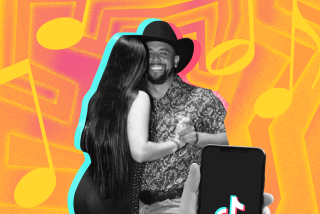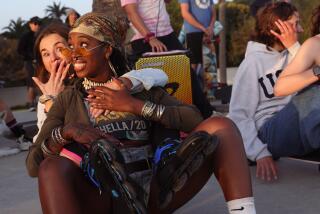As L.A. reopens, salsa dancing into the orange tier on Venice Beach

- Share via
I approach the south end of Venice Beach with trepidation, mask on, and already it feels like the area is surging with human electricity.
Cars are packed in pointless traffic toward the Venice Pier. Bike crews blasting trap are clustered near Hinano Cafe, the dive-y beach grill. One man stands on a corner screaming toward the shore. Tourists from out-of-state are clear: anyone who looks a little more polished, slightly more mannered. The Whaler is slammed.
On this recent weekend afternoon, Los Angeles careens into the orange tier with dipping cases and deaths in the pandemic and a widespread social loosening of mask culture that’s less easy to quantify but evident on the streets.
The beginning of spring offers jarring opportunities for cleansing and rebirth. All around me lately in the city, it is as though despite the collective trauma and grieving stewing within us in the COVID era, people are becoming more eager to shake off the blues.
Along the L.A. coast, I see spontaneous drum circles, raves and other expressive actions popping up against the receding pandemic. In L.A., another secret local truism is that Angelenos of every class and color are actually terribly rebellious and prone to occupying or liberating public space without proper permissions.
A friend tells me I need to see a scene happening near the pier: salsa and bachata dancing near picnic tables usually crowded with the coastal unhoused. It started small around January at the pier’s parking lot, drawing a community of those displaced from indoor dance floors. Now there’s a sound system.
The soothing drips of the bachata music draw me to the picnic tables and I am amazed by what I see: synced couples fiercely switching their hips against one another, tight and close. This being the Westside, a good portion of the people look and move like professional or semi-professional dancers. Few are in masks. But everyone looks great, even in beach attire.
A wave of doubt catches me. It feels like I’m in the ninth grade again. I am at my first formal dance, made anxious by the music because I like it and because I know I will want to dance. Eventually, I’ll have to ask someone or someone will have to ask me.
Men dip women low, manes of sun-kissed hair arcing down to the sandy concrete. Facial expressions pop with glee. There is release. Return. A stop just so. Double turns. Triple turns. A pause between songs and the space adjusts.
“I don’t really know what this is,” I say to my friend, badly masking that innate fear of a new dance floor. Others also watch. “I’m more of a cumbiero,” I add defensively.
I’m referring to Mexico City-style cumbia, from my days running around that city in my late 20s going to everything. Sonidero cumbia. Sweaty, subwoofer-stacked, beer-addled cumbia. Cumbia to die for. What’s the only way to make all Latin peoples get along? Dance and music. Cumbia came from Colombia but we love it in Mexico. Salsa is Cuban and Californians are obsessed with it. Bachata is from the Dominican Republic. All have Africa as a central rhythmic root.
As the tracks run, my hips begin swaying reflexively. I am more intimidated than ever, hanging with a patch of ladies who proclaim themselves to be adherents of Brazilian samba. They also seem to question their role in this new environment. “I hope they play samba,” one frowns. But they won’t. This scene is specified.
A SoCal upbringing, dancing
I can dance a little salsa if pressed. At house parties in Southern California barrios, you simply grow up dancing. Older relatives yank you onto the floor in front of everyone and teach you a step or two. After a while, you just pick things up. For me, in the Mexican American context, it is the same with cumbia, with quebraditas, norteñas, even zapateadas. Salsa is more complex, flashy, but its turns are similar to an uptempo cumbia dance style that’s popular in the Mexico City salones I once frequented.
Put on some music, let me observe for a while and maybe I’ll try it.
The only time I failed at this knack was when I visited La Catedral, the famous milonga in Buenos Aires, and tried to dance tango with no lesson ever. I must have looked like I was trying to waltz — that is, looked ridiculous! — until my partner firmly told me she couldn’t dance with me and walked away.
Here, a few really drunk or unhoused dancers ease the expectations. The regulars are indifferent. I quickly confirm we are surrounded by serious L.A. salsa instructors, club-goers and aficionados. The organizers are welcoming to strangers but less so to a reporter’s questions.
After the track changes to a slower rhythm, closer to cumbia’s bass-driven ease, I find a potential partner and we fidget. In a few moments, our hips are swaying so close to one another it becomes almost instinct to turn to her, this friend of a friend, and offer a hand.
She takes it. We dance. My mask comes off my nose. I pray for forgiveness from the pandemic watchdogs. I’m carrying a rhythm with another human, our bodies close. I can’t remember the last time I did this.
“I’m more, like, into cumbia,” I tell her shoulder.
“Oh, you know what you’re doing,” my partner responds after a spin.
A woman nearby shoots her arms into the air and screams: “I feel like I’m out of jail!”
How deeply have we isolated ourselves in the first year of this pandemic? How long can our digital lives sustain us? I suspect on this Sunday that virtual life will never be enough.
I thank my partner for the dance. “I get it,” she says with a smile. “Follow, follow, follow.” I feel a quick flash of shame at my style. It is what it is. The next song starts and pairings readjust.
The sun sinks over the break lines. I’m thinking about how much we’ve suffered and lost and how nearly every gesture in daily affairs now poses a calculated risk to health, but also a valve for connection. How can we rebuild our culture while honoring those we’ve lost? I look around and wonder if salsa and bachata, for Los Angeles’ sake, can be considered essential activities.
I leave feeling 10 times better. Maybe gestures like this can help us heal after this brutal time: a spontaneously sprung dance party by the beach, in a city that will never be the same again.
More to Read
The biggest entertainment stories
Get our big stories about Hollywood, film, television, music, arts, culture and more right in your inbox as soon as they publish.
You may occasionally receive promotional content from the Los Angeles Times.











